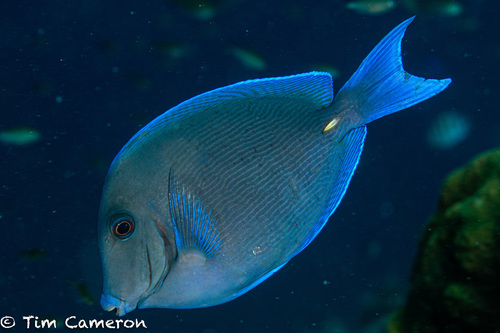
Blue Tang
The Atlantic bluefin tuna (*Thunnus thynnus*) is a magnificent and highly migratory species of tuna found in the Atlantic Ocean. Renowned for its size, speed, and commercial value, it plays a crucial role in the marine ecosystem. This species is a top predator.
30 45 years
Lifespan
23 - 35 cm
Length
Least Concern
Conservation Status
5 km/h
Swimming speed
Herbivorous, Planktivorous
Diet
Local Migration
Migration
Appearance Overview
The Atlantic bluefin tuna is a large, torpedo-shaped fish with a streamlined body built for speed and endurance.
Coloration
Dark metallic blue on the dorsal side, silvery-white on the ventral side
Fins
Two dorsal fins, the first depressible; small finlets behind the second dorsal and anal fins
Body Shape
Torpedo-shaped and streamlined
Scales
Small and cycloid
Length
Up to 13 feet (4 meters)
Weight
Up to 2,000 lbs (907 kg)
Diet
Carnivorous, feeding on a variety of fish (such as herring, mackerel, and hake), squid, and crustaceans.
Feeding Behavior
Highly active predator, using speed and coordinated hunting strategies to capture prey. They are opportunistic feeders, often consuming whatever is abundant.
Social Behavior
Forms schools, especially when young. Larger individuals are more solitary or form smaller groups. Exhibits complex migratory patterns.
Commercial Relevance
Extremely high value, particularly in the sushi and sashimi markets of Japan. This demand drives intensive fishing pressure.
Conservation measures
Subject to international fishing quotas and regulations managed by organizations like ICCAT. Marine Protected Areas (MPAs) and fishing gear restrictions are also employed.
Status
Endangered (IUCN)
Threats
Overfishing (historically and ongoing), bycatch in other fisheries, climate change affecting prey distribution and spawning grounds, and habitat degradation.
Habitat Distribution
Depth Range
0-1,000 meters (typically in the epipelagic and mesopelagic zones)
Geographic Range
Atlantic Ocean, Mediterranean Sea, Gulf of Mexico
Preferred Environment
Temperate and subtropical waters; open ocean, often near continental shelves and slopes
Reproduction and Life Cycle
Breeding Habits
Spawns in warm waters, with major spawning grounds in the Mediterranean Sea and the Gulf of Mexico. Spawning typically occurs in spring and summer.
Development Stages
Eggs are pelagic (free-floating). Larvae develop rapidly, feeding on plankton. Juveniles grow quickly, forming schools and gradually transitioning to a diet of larger prey.
Fecundity
Highly fecund; a single large female can produce up to 30 million eggs per spawning season.
Maturity Age
Matures relatively late, at around 4-8 years in the Mediterranean and 8-12 years in the western Atlantic.
Faqs about Blue Tang
Where are Atlantic bluefin tuna found?
Atlantic bluefin tuna are found in the Atlantic Ocean, ranging from the Gulf of Mexico and the Mediterranean Sea to as far north as Norway and Iceland.
How long do Atlantic bluefin tuna live?
They can live up to 40 years, although many don't reach this age due to fishing pressure.
How fast can Atlantic bluefin tuna swim?
They are among the fastest fish in the ocean, capable of bursts of speed up to 40-60 mph.
Are Atlantic bluefin tuna warm-blooded?
Yes, they are warm-blooded, able to maintain a body temperature higher than the surrounding water, which aids in their speed and endurance.
Why do Atlantic bluefin tuna migrate?
Their large size, powerful muscles, and warm-bloodedness allow them to undertake long migrations across the Atlantic Ocean for feeding and spawning.
What do Atlantic bluefin tuna eat?
Atlantic bluefin tuna primarily feed on smaller fish, squid, and crustaceans. They are opportunistic predators.
How many eggs do Atlantic bluefin tuna lay?
Females can release millions of eggs per spawning season. The exact number varies depending on the size and condition of the fish.
Why are Atlantic bluefin tuna endangered?
Because of their high value in the sushi market, leading to intense fishing pressure that has severely depleted their populations.
What organizations manage the conservation of bluefin tuna?
ICCAT (International Commission for the Conservation of Atlantic Tunas) is the primary organization responsible for setting fishing quotas and managing bluefin tuna stocks.
Copyright @ Nature Style Limited. All Rights Reserved.
 English
English